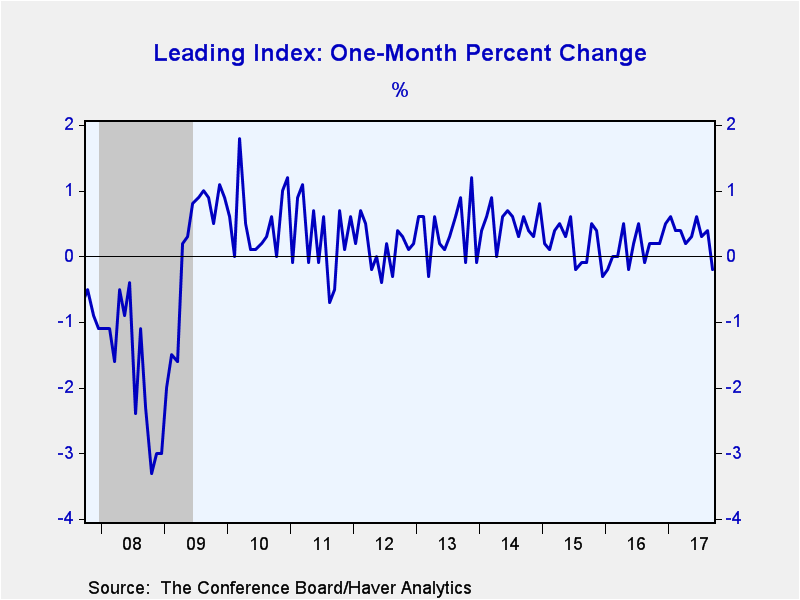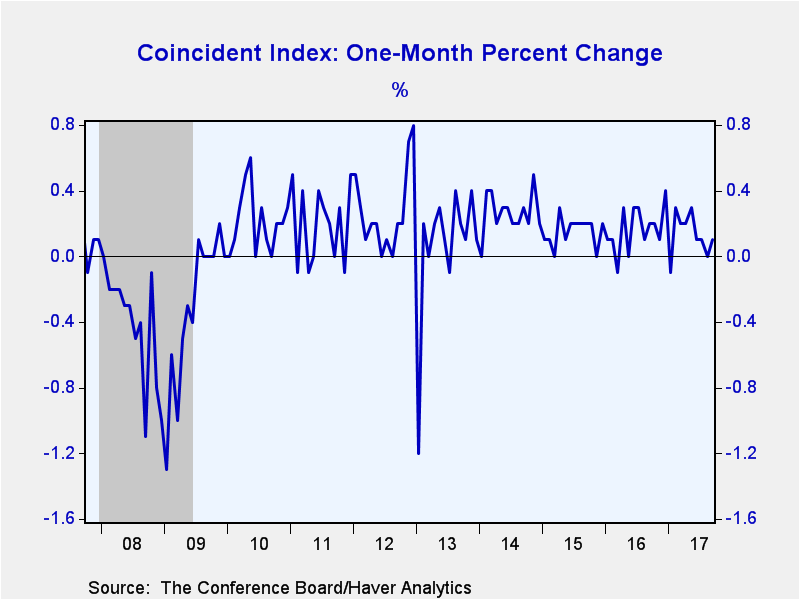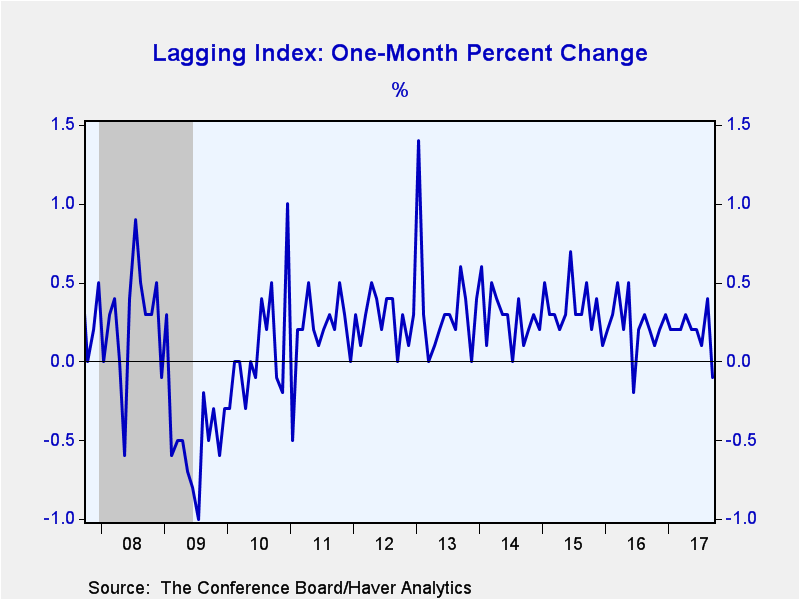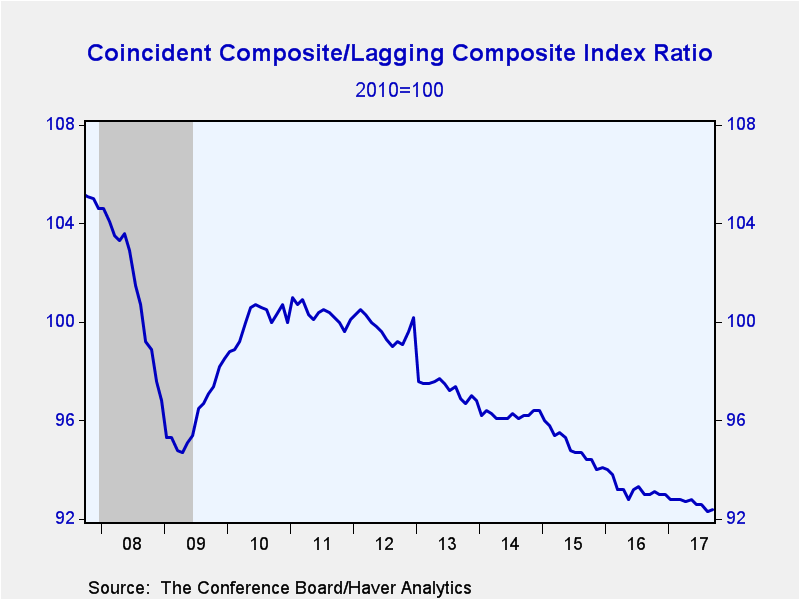 Global| Oct 19 2017
Global| Oct 19 2017U.S. Leading Economic Indicators Slip
by:Tom Moeller
|in:Economy in Brief
Summary
The Conference Board's Composite Index of Leading Economic Indicators eased 0.2% (+4.0% y/y) during September following an unrevised 0.4% August increase. A 0.1% rise had been expected in the Action Economics Forecast Survey. Three- [...]
The Conference Board's Composite Index of Leading Economic Indicators eased 0.2% (+4.0% y/y) during September following an unrevised 0.4% August increase. A 0.1% rise had been expected in the Action Economics Forecast Survey. Three-month growth deteriorated to 2.2% (AR) from 5.5%.
Performance amongst several of the components of the leading indicator series deteriorated. The average workweek, building permits, initial unemployment insurance claims, orders for nondefense capital goods excluding aircraft and building permits each registered negative effects on the index. Consumer expectations for business/economic conditions and new orders for consumer goods had lessened positive effects. A steeper interest rate yield curve had a steady positive impact on the index, though it was reduced substantially from earlier in the recovery. To the upside, the positive effects from the ISM orders series and the stock price series improved.
The Index of Coincident Economic Indicators ticked 0.1% higher (1.7% y/y) following an unrevised zero change in August. Gains in industrial production, personal income less transfer payments and business sales were countered by a decline in payroll employment. Three-month growth in the index held steady m/m at 0.7% (AR), down from 2.5% in May.
The Index of Lagging Economic Indicators slipped 0.1% (+2.4% y/y) following an upwardly revised 0.4% increase. A longer average duration of unemployment had a sharp negative effect on the index. Commercial & industrial loans outstanding, the consumer credit-to-personal income ratio and the change in the services CPI had positive effects. Three-month growth in the lagging index fell sharply to 1.6%
The ratio of coincident-to-lagging indicators is often considered to be a leading indicator of economic activity. If economic growth is moderating, both sets of indicators will be rising, but the gains in the coincident index will be slower than the lagging; thus, the ratio will fall. This ratio improved slightly last month from its record low.
The Conference Board figures are available in Haver's BCI database; the components are available there, and most are also in USECON. The expectations are in the AS1REPNA database. Visit the Conference Board's site for coverage of leading indicator series from around the world.
The Fed's latest Beige Book covering regional economic conditions is available here.
| Business Cycle Indicators (%) | Sep | Aug | Jul | Sep Y/Y | 2016 | 2015 | 2014 |
|---|---|---|---|---|---|---|---|
| Leading | -0.2 | 0.4 | 0.3 | 4.0 | 1.2 | 4.4 | 5.6 |
| Coincident | 0.1 | 0.0 | 0.1 | 1.7 | 1.6 | 2.3 | 2.5 |
| Lagging | -0.1 | 0.4 | 0.1 | 2.4 | 3.4 | 3.7 | 3.6 |
Tom Moeller
AuthorMore in Author Profile »Prior to joining Haver Analytics in 2000, Mr. Moeller worked as the Economist at Chancellor Capital Management from 1985 to 1999. There, he developed comprehensive economic forecasts and interpreted economic data for equity and fixed income portfolio managers. Also at Chancellor, Mr. Moeller worked as an equity analyst and was responsible for researching and rating companies in the economically sensitive automobile and housing industries for investment in Chancellor’s equity portfolio. Prior to joining Chancellor, Mr. Moeller was an Economist at Citibank from 1979 to 1984. He also analyzed pricing behavior in the metals industry for the Council on Wage and Price Stability in Washington, D.C. In 1999, Mr. Moeller received the award for most accurate forecast from the Forecasters' Club of New York. From 1990 to 1992 he was President of the New York Association for Business Economists. Mr. Moeller earned an M.B.A. in Finance from Fordham University, where he graduated in 1987. He holds a Bachelor of Arts in Economics from George Washington University.










